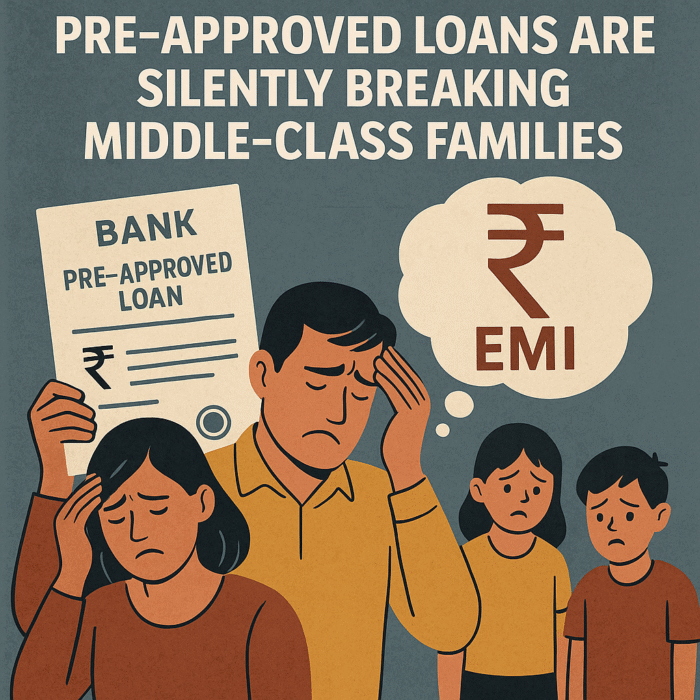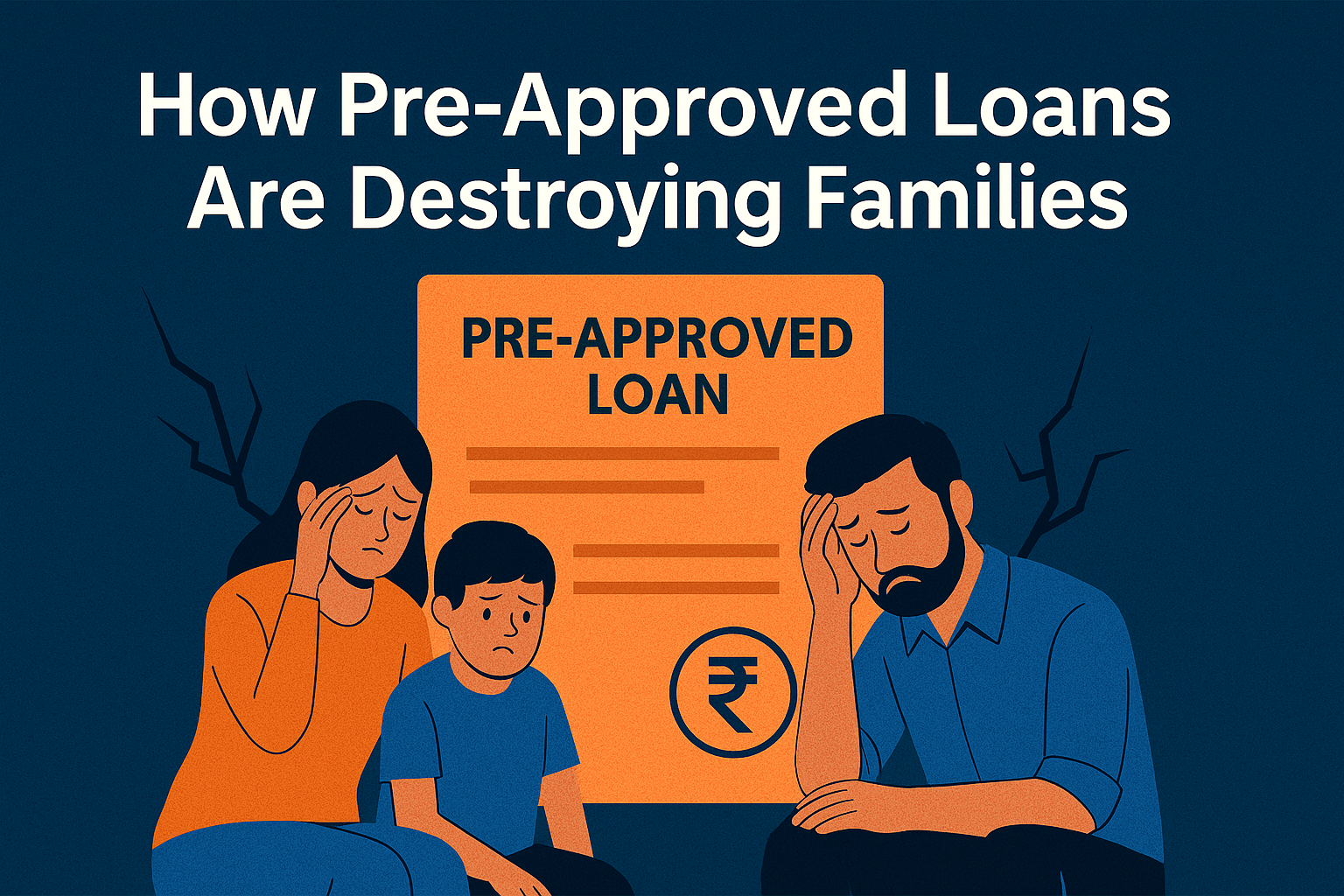Table of Contents
Introduction
In today’s digital world, pre-approved loans are being pushed onto middle-class families like never before. In a time when convenience and speed dominate financial services, pre-approved personal loans have emerged as an enticing offering. They appear like a lifeline, especially to India’s middle-class families, who often struggle to meet their ever-growing financial needs. Banks and NBFCs bombard individuals with SMSes, emails, and app notifications: “You are eligible for ₹5 lakh pre-approved personal loan — no documents required!”
It sounds perfect. No paperwork. No questions asked. Quick money at your fingertips. But beneath this glittering promise lies a growing crisis — one that is tearing apart the financial and emotional fabric of middle-class Indian families.
To the average middle-class Indian, already juggling school fees, rent, EMIs, and family responsibilities, this feels like a blessing. But behind this illusion of easy credit lies a dark truth — many families are unknowingly walking into a financial trap that’s destroying peace at home, straining relationships, and collapsing household stability.

The Middle-Class Dilemma: Too Much to Handle, Too Little to Fall Back On
India’s middle class, often with limited income and big dreams, is constantly under pressure to “upgrade” — better education, home appliances, weddings, vacations, or sudden emergencies. When salaries fall short, pre-approved loans appear to be the easy fix.
In such a setting, pre-approved loans appear like a miracle. There is no need to queue at banks, explain one’s purpose, or submit documents. Money arrives in your account within minutes. But this illusion of financial empowerment comes at a high cost.
But here’s the problem: these loans are given without any income verification, credit assessment, or household budget analysis. Banks rely solely on past transactions or CIBIL scores — ignoring whether the borrower can actually afford to repay.
🧨 Result? Families are borrowing more than they earn — and they don’t even realize it until it’s too late.
Real Story: When EMIs Crossed Their Income
A Pune-based schoolteacher and her husband, a private employee, availed three pre-approved loans over two years — for a vacation, new electronics, and a relative’s wedding gift. With no clear budgeting, they didn’t realize their monthly EMIs had ballooned to ₹48,000 — while their combined net salary was ₹46,500.
They started defaulting. Creditors began calling. Their daughter had to drop out of private tuition. Fights became frequent. Peace vanished. This is not an isolated case.
Why Are Pre-Approved Loans Dangerous for Middle-Class Families?
1. 🧾 No Income Check or Documentation
Pre-approved loans bypass traditional credit checks. No verification of current income, liabilities, or employment status is done. A person may have lost a job or taken other loans — but still gets another pre-approved offer.
2. 💳 Multiple Loans, Zero Tracking
Middle-class borrowers often take multiple small-ticket loans — ₹50K here, ₹1L there — thinking they can manage. But without tracking the total EMI burden, they soon find themselves deep in debt.
3. 💔 Family Stress and Breakdown
EMI pressure leads to emotional stress. Many borrowers hide their loans from spouses or parents, fearing judgment. When the truth comes out — it results in fights, blame, and even separation in extreme cases.
4. 😰 Harassment by Recovery Agents
Once a borrower defaults, recovery agents start calling — at home, at work, even friends and relatives. For a middle-class family, this is humiliating and emotionally devastating.
Families Often Don’t Know They’re in Trouble
One of the most dangerous aspects of pre-approved loans is how quietly they infiltrate a family’s financial stability. Unlike large-term loans that come with significant paperwork and planning, pre-approved loans are marketed as quick, painless fixes — offered over a phone call, an SMS, or a banking app. Because they are easy to access and often small in size, families fail to recognize the cumulative impact of these liabilities.
What’s worse is that many middle-class households never sit down to assess their overall monthly EMI burden. There is no budgeting exercise, no debt-to-income analysis. Often, one partner may take a loan without informing the other, assuming it’s just a minor addition. However, these minor additions can snowball quickly. The convenience of auto-debit features further masks the seriousness of the growing EMI load.
In some cases, the total monthly outgo in EMIs quietly surpasses the family’s actual income, forcing them to borrow from friends, delay school fees, or miss utility payments. But by the time the alarm bells ring, it’s often too late — the debt cycle has already begun. Families start living in denial or secrecy, ignoring the problem until it spirals into emotional distress and financial collapse.
Many households don’t calculate their Debt-to-Income (DTI) ratio. They assume that if EMIs are being auto-debited, all is fine. But they fail to consider upcoming school fees, medical needs, or even sudden job loss.
📊 Ideal DTI should be <30%. But many Indian households unknowingly operate at 50–60% EMI load — well above sustainable levels.
Why Are Lenders So Aggressive With Pre-Approved Loans?
Banks and NBFCs treat these pre-approved loans as low-risk, high-profit products. Since these loans are unsecured and short-tenured, interest rates are higher. There is no operational cost of processing, no documentation handling, and almost no human involvement.
It is driven by algorithms that target people based on spending patterns, existing loans, or even app usage. And once the first loan is repaid, the borrower is flooded with bigger and easier offers.
It is loan pushing, not financial support.
What Can RBI and the Government Do?
It’s time for systemic change. Here’s how regulators and policymakers can step in:
✅ 1. Mandate Income-Linked Loan Sanctioning
Pre-approved loans must not be offered without income verification. Lenders should be required to obtain latest salary slips, IT returns, or bank statements before disbursing the loan.
✅ 2. Set a Universal EMI-to-Income Cap
RBI should introduce guidelines capping EMIs at 35–40% of verified income. Beyond this, no additional loans should be approved — pre-approved or otherwise.
✅ 3. Centralized Credit Tracking
A real-time platform (like a borrower dashboard via CIBIL or RBI) should be accessible to citizens, showing:
- Active loans
- Total EMI load
- Remaining balance
This helps households see the big picture before taking on more debt.
✅ 4. Financial Literacy Campaigns
Launch nationwide awareness drives about:
- The risks of easy loans
- How to calculate DTI
- How defaulting impacts credit and family life
Schools and offices should also promote financial education — before problems begin.
How Middle-Class Families Can Protect Themselves
- 💡 Always calculate EMIs vs. net income. Use loan calculators.
- 🛑 Don’t borrow for non-essential purchases (gadgets, parties, gifts).
- 🧠 Involve your spouse/family before taking any loan. Don’t hide loans. Take collective decisions. Transparency prevents financial surprises.
- 📋 Maintain a loan diary: note every EMI, interest rate, tenure, and remaining balance. Document all loans, EMIs, interest rates, and due dates. Review them monthly.
- 🧓 Talk to a financial advisor before refinancing or taking new credit.
Conclusion: Don’t Let a Loan Ruin Your Home
Pre-approved loans promise speed, but they skip responsibility — both from the lender and the borrower.
For India’s middle class, which already walks a tightrope between aspiration and affordability, this form of lending is proving to be destructive. It’s time to wake up, speak up, and make responsible credit choices. And it’s time for banks, the RBI, and the government to stop looking away and start protecting the very families that are the backbone of this nation




